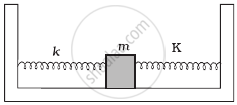Advertisements
Advertisements
Question
Which of the following statements is/are true for a simple harmonic oscillator?
- Force acting is directly proportional to displacement from the mean position and opposite to it.
- Motion is periodic.
- Acceleration of the oscillator is constant.
- The velocity is periodic.
Solution
a, b and d
Explanation:
Simple harmonic motion is a type of periodic motion or oscillation motion where the restoring force is directly proportional to the displacement and acts in the direction opposite to that of displacement. When the system is displaced from its equilibrium position, a restoring force that obeys Hooke’s law tends to restore the system to equilibrium. As a result, it accelerates and starts going back to the equilibrium position.
An oscillation follows simple harmonic motion if it fulfils the following two rules:
- Acceleration is always in the opposite direction to the displacement from the equilibrium position.
- Acceleration is proportional to the displacement from the equilibrium position.
Let us write the equation for the SHM x = a sin(ωt + `phi`)
Clearly, it is a periodic motion as it involves since function.
Let us find velocity of the particle, `v = (dx)/(dt)`
= `d/(dt) (a sin(ωt + phi))`
= `aω cos(ωt + phi)`
Velocity is also periodic because it is a cosine function.
Now let us find acceleration, `A = (dv)/(dt)`
= `(d^2x)/(dt^2)`
= `- aω^2 sin(ωt + phi)`
The acceleration is a sine function, hence cannot be constant.
⇒ `A = - (ω^2a) sin(ωt + phi) = - ω^2x`
Force, F = Mass × Acceleration
= mA
= – mω2x
Hence, force acting is directly proportional to displacement from the mean position and opposite to it.
APPEARS IN
RELATED QUESTIONS
A spring having with a spring constant 1200 N m–1 is mounted on a horizontal table as shown in Fig. A mass of 3 kg is attached to the free end of the spring. The mass is then pulled sideways to a distance of 2.0 cm and released.

Determine (i) the frequency of oscillations, (ii) maximum acceleration of the mass, and (iii) the maximum speed of the mass.
Answer the following questions:
The motion of a simple pendulum is approximately simple harmonic for small angle oscillations. For larger angles of oscillation, a more involved analysis shows that T is greater than `2pisqrt(1/g)` Think of a qualitative argument to appreciate this result.
Answer the following questions:
A man with a wristwatch on his hand falls from the top of a tower. Does the watch give correct time during the free fall?
A simple pendulum of length l and having a bob of mass M is suspended in a car. The car is moving on a circular track of radius R with a uniform speed v. If the pendulum makes small oscillations in a radial direction about its equilibrium position, what will be its time period?
If the particle starts its motion from mean position, the phase difference between displacement and acceleration is ______.
The relation between acceleration and displacement of four particles are given below: Which one of the particles is executing simple harmonic motion?
A particle executing S.H.M. has a maximum speed of 30 cm/s and a maximum acceleration of 60 cm/s2. The period of oscillation is ______.
Two identical springs of spring constant K are attached to a block of mass m and to fixed supports as shown in figure. When the mass is displaced from equilibrium position by a distance x towards right, find the restoring force

When will the motion of a simple pendulum be simple harmonic?
A particle at the end of a spring executes simple harmonic motion with a period t1, while the corresponding period for another spring is t2. If the period of oscillation with the two springs in series is T, then ______.
